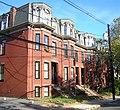
The Suffolk County Courthouse, now formally the John Adams Courthouse, is a historic courthouse building in Pemberton Square in Boston, Massachusetts. It is home to the Massachusetts Supreme Judicial Court and the Massachusetts Appeals Court. Built in 1893, it was the major work of Boston's first city architect, George Clough, and is one of the city's few surviving late 19th-century monumental civic buildings. It was added to the National Register of Historic Places in 1974.

The Broadway Winter Hill Congregational Church is a historic church building at 404 Broadway in Somerville, Massachusetts. Built in 1890–91 to a design by Hartwell and Richardson for a Congregationalist congregation founded in 1865, it is one of the city's only examples of Shingle style architecture, and one of its finer architect-designed buildings from the 19th century. The building was listed on the National Register of Historic Places in 1989. It is now home to the Vida Real Church.

The First Universalist Church is a historic Universalist Church building at 125 Highland Avenue in Somerville, Massachusetts. The Romanesque church building was built between 1916 and 1923 to a design by Ralph Adams Cram, and is the only example of his work in Somerville. The building was listed on the National Register of Historic Places in 1989. It is currently owned by the Highland Masonic Building Association, and is the home of King Solomon's Lodge AF & AM, the builders of the Bunker Hill Monument.

The Boardman is a series of rowhouses at 39-53 Montana Street, occupying an entire city block between Hoosac and Blackinton Streets in North Adams, Massachusetts. The building was, at the time of its construction (1899–1901), one of the most elaborate multiunit buildings in the city, and were added to the National Register of Historic Places in 1985.

The Hathaway Tenement is a historic tenement house located in North Adams, Massachusetts. A row of six apartment units, it was built in about 1850, and is a rare surviving example of worker housing dating to the early period of North Adams' industrial development. It was added to the National Register of Historic Places in 1985.
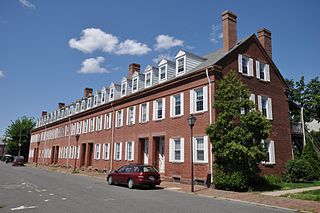
The Hadley Falls Company Housing District is a residential historic district encompassing a compact tract of factory worker housing in Holyoke, Massachusetts. Built in 1847-48, it is one of the earliest and largest surviving examples of company-built worker housing in the state. It includes five rowhouses facing Center, Lyman, Grover, and Canal Streets. The district was listed on the National Register of Historic Places in 1972.

The Charles Adams-Woodbury Locke House is an historic house in Somerville, Massachusetts. The Greek Revival house was built about 1840 for a Boston leather merchant and was one of the first residences of a commuter, rather than a farmer, in the Winter Hill neighborhood of the city. The house was listed on the National Register of Historic Places in 1989.

The Adams-Magoun House is a historic house at 438 Broadway in Somerville, Massachusetts. Built about 1783, it is one of the city's few surviving 18th-century buildings and its best-preserved. It was listed on the National Register of Historic Places in 1989.
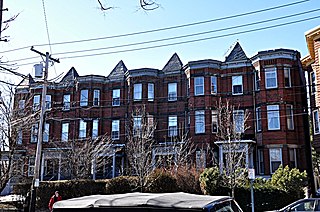
The houses at 28–36 Beacon Street in Somerville, Massachusetts are a series of Queen Anne style brick rowhouses. The five identical houses were built c. 1880 on land formerly part of a brickyard owned by George Wyatt, whose own house stands across the street. The facade of each house is divide vertically into two sections: the left one is flat, and is topped by a square turret roof, with a single story portico sheltering double entrance doors, and the right sight is a polygonal project bay rising the full three stories. The shallow roof cornices are studded with brackets.

The James H. Brooks House is a historic house in Somerville, Massachusetts. Built about 1880, it is one of the finer examples of Second Empire architecture in the city. It was listed on the National Register of Historic Places in 1989.

The Langmaid Building is a historic multiunit residence building in Somerville, Massachusetts, USA. The brick rowhouse was one of several Second Empire multiunit buildings built in the late 1870s and early 1880s by Samuel Langmaid and other members of his family. This particular series of units has decorative panel brick insets, and the characteristic slate mansard roof. This building was the first to be built of brick in the area, marking a shift away from wood-frame construction that dominated the area.

The S. E. Brackett House is a historic house in Somerville, Massachusetts, United States. Built about 1880, it is one of the city's most elaborate examples of Second Empire architecture. It was listed on the National Register of Historic Places in 1989.
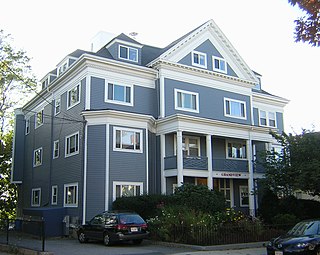
The Grandview is a historic apartment hotel at 82 Munroe Street in Somerville, Massachusetts. This type of building was not uncommon in the city at the time of its 1896 construction. This building affords commanding views of the Boston area from its site near the top of Prospect Hill, and has well-preserved Colonial Revival styling. The building was listed on the National Register of Historic Places in 1989.

The Joseph Temple House is a historic house in Reading, Massachusetts. The Second Empire wood-frame house was built in 1872 by Joseph Temple, owner of locally prominent necktie manufacturer. The house was listed on the National Register of Historic Places in 1984.
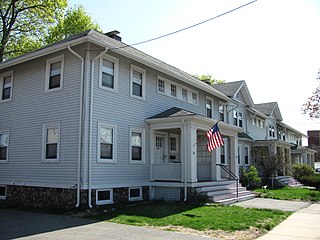
The building at 38–48 Richardson Avenue is a historic residential rowhouse in Wakefield, Massachusetts. Built c. 1912, is believed to be one of the oldest rowhouses in the town. They were built by Solon O. Richardson, Jr., on a portion of his family's estate. The building was listed on the National Register of Historic Places in 1989.

Boston Manufacturing Company Housing are historic residential housing blocks at 380–410 and 153–165 River Street in Waltham, Massachusetts. The housing was for the Boston Manufacturing Company (BMC), the earliest modern manufacturing facility in the United States. The housing was built in the nineteenth century and the two blocks of buildings were separately added to the National Register of Historic Places in 1989.

The George Cowdrey House is a historic house at 42 High Street in Stoneham, Massachusetts. It was built about 1865 for George Cowdrey, a local shoe manufacturer and state legislator, and is one of the town's finest examples of residential Second Empire architecture. It was listed on the National Register of Historic Places in 1984.

The H. M. Warren School is a historic school building at 30 Converse Street in Wakefield, Massachusetts. Built c. 1895–1897, it is locally significant as a fine example of Renaissance Revival architecture, and for its role in the town's educational system. The building was listed on the National Register of Historic Places in 1989. It now houses social service agencies.
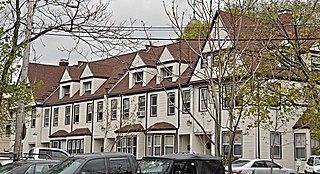
1–6 Walnut Terrace in the Newtonville village of Newton, Massachusetts is a distinctive Shingle style rowhouse. Built in 1887, it is one of the city's few examples of a 19th-century rowhouse. The building was listed on the National Register of Historic Places in 1986.

District D is a historic worker housing district located in Manchester, New Hampshire, near the former Amoskeag Manufacturing Company millyard. It is roughly bounded by Canal, Langdon, Elm, and West Brook streets, and was added to the National Register of Historic Places on November 12, 1982. It contains three residential buildings constructed in 1864 in an area of about 3 acres (1 ha).



